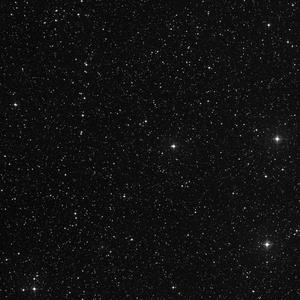IC 4432

Overlaid DSS image of IC 4432, 60' x 60' with north at top and west to the right
Aladin viewer for the region around IC 4432
| Type | Unknown |
|---|---|
| Magnitude | Right Ascension | 14h 28' 49.7" (2000) |
| Declination | 39° 33' 8" S |
| Constellation | Centaurus |
| Description | vF, vS, mE 85deg |
Observing Notes
Harold Corwin
This is Delisle Stewart's No. 406 in the Harvard Annals, Volume 60. It is usually taken as ESO 326- G025, but there are several problems with that identification that led Malcolm Thomson to list IC 4432 as "not found". This, in turn, led Courtney Seligman, early in January 2014, to question my unnoted acceptance of the ESO galaxy (also known as PGC 51727) as the IC object.
Looking again at the problem, I now believe that the IC object may well be an asterism. Here is the story, based on what I wrote to Courtney:
I'm pretty sure now that PGC 51727 is not the IC object. Courtney pointed out that the position angle is wrong, and that is where a good part of the doubt comes in. The position itself is not a particularly big problem as Stewart's positions were estimated using overlays; digit errors are, if not frequent, at least present in his list (see e.g. IC 4430). And the declination is well within Stewart's nominal errors (2+- arcmin), so the 1.5 arcmin difference is not a serious problem, either.
But the major problem here is that the plate on which IC 4432 was found was a one-hour exposure with a slow, blue emulsion using the 24-inch Bruce telescope at Arequipa in Peru. Here is an interesting statement, probably by Edward Pickering, Harvard's director at the time, from HA 60 where IC 4432 was first listed: "Nearly fourteen times as many new nebulae were found, on the average, on the plates of four hours exposure as on those of one hour exposure. It appears, therefore, that the NGC contains, in general, nearly as faint nebulae as can be photographed with the Bruce Telescope, with an exposure of one hour." (Pickering gives numbers that back up this calculation.) So, I doubt very much that PGC 51727 is the IC object as it would have to have been about as bright as a faint southern NGC object to show up on a one-hour plate. Instead, it is considerably fainter than that.
I would look instead to a couple of the asterisms in the area of the position given by Stewart. One of these in particular caught my eye: the line of five stars just southeast of Stewart's position (the positions of the stars are in the position table). The position angle of the line is close to Stewart's 85 degrees, and its length is such that it could mimic a small, edgewise galaxy. We'd need to look at the Harvard plate to be sure about this, of course. I also see another line of three stars, also with a PA of 85-90 degrees, just west of Stewart's position; positions for those stars are also in the table.
It's also possible that plate defects are involved here. That would of course need to be verified on the plate as well.
Other Data Sources for IC 4432
Nearby objects for IC 4432
5 objects found within 120'
| a Centauri | HD 127193 | HD 127971 |
| HD 128207 | IC 4421 |
Credits...
Drawings, descriptions, and CCD photos are copyright Andrew Cooper unless otherwise noted, no usage without permission.
A complete list of credits and sources can be found on the about page
IC 4432